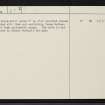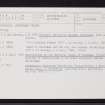Aberdeen, Dominican Friary
Cist (Period Unassigned), Friary (Medieval)
Site Name Aberdeen, Dominican Friary
Classification Cist (Period Unassigned), Friary (Medieval)
Alternative Name(s) Royal Palace; Grammar School; Monastery
Canmore ID 20147
Site Number NJ90NW 27
NGR NJ 9389 0640
Datum OSGB36 - NGR
Permalink http://canmore.org.uk/site/20147
- Council Aberdeen, City Of
- Parish Aberdeen
- Former Region Grampian
- Former District City Of Aberdeen
- Former County Aberdeenshire
NJ90NW 27.00 9389 0640
NJ90NW 27.01 NJ 9393 0634 Cist: Long
For Franciscan friary (NJ 9425 0650) and Carmelite friary (NJ 9411 0608), see NJ90NW 26 and NJ90NW 49 respectively.
(NJ 9389 0640) Site of Monastery (NR) (Dominican or Black Friars)
OS 1:500 map, Aberdeenshire, 2nd ed., (1901).
(NJ 9392 0634) Cist found (NAT)
OS 25" map, (1955).
The site of a Dominican house founded between 1230 and 1249 by Alexander II, who is said to have bestowed on it his palace and garden situated between Schoolhill, Blackfrairs Street, Woolmanhill, St Andrews Street and Harriet Street. The bounding wall of the property, 'very high but for the most part ruined', was extant in 1661, although both the monastery and its church, dedicated to St. John the Baptist, had been completely destroyed by reformers in 1560.
Excavations in 1833 revealed a south-facing building belonging to the monastery,as well as a stone-built grave 6' by 4'of unworked stones cemented with lime and containing three bodies, one of them apparently young. The site is now occupied by Robert Gordon's College.
Visited by OS (JLD) 20 August 1952.
Name Book 1866; W kennedy 1818; D E Eassonn 1957; W Macfarlane 1907.
Long cist with multiple inhumations. The monastery is first mentioned c. 1262 and was demolished 1881, the site later being occupied by the Art School and currently by Robert Gordon's College.
NMRS, MS/712/83.
Nothing is visible of this friary and its site now lies in a redeveloped part of the city.
Visited by RCAHMS (JRS, ATW), 26 February 1997.
Publication Account (1997)
The Dominican Friary (a house of the Dominican or Black Friars) is said to have been founded in Aberdeen by Alexander II sometime between 12221 and 1249. There is some evidence that it was in existence by 125 7 and from the fourteenth century it features regularly in documentary sources. The friary was situated on the outskirts of urban settlement on the later-named Schoolhill at a site now occupied by part of Robert Gordon's College, the Robert Gordon University, and Aberdeen Art Gallery. There are few details of the layout of the friary, but newspaper articles detailing the finds made during building operations on the site between 1833 and 1923 appear to indicate that the main complex and church were situated at the present college gymnasium. As well as the church and the usual residential and domestic buildings, which presumably existed, there was a barn, a kiln, a dovecot and a garden and orchard. By 1503, the complex housed a prior and thirteen friars. The house was destroyed by the Protestant reformers in 1560, and its pertinent passed to George, Earl Marischal in 1587 who endowed them on the new Marischal College.
Excavation and observation during building works has so far produced no direct evidence of the friary (see 2-16 Harriet Street; 28 Harriet Street; and Rear of Aberdeen Art Gallery, below), but, given the historical importance of the friary, archaeological monitoring of any future works in this vicinity is strongly recommended.
Information from ‘Historic Aberdeen: The Archaeological Implications of Development’ (1997).
Watching Brief (22 October 2015 - 1 January 2018)
AOC Archaeology Group was commissioned by Gareth Hoskins Architects on behalf of their client Aberdeen City Council to carry out a watching brief on groundworks associated with the redevelopment of Aberdeen Art Gallery. The gallery has been constructed on the grounds of a Dominican friary, apparently founded by Alexander II sometime between 1230 - 1249. Excavations outside the gallery uncovered a red brick charnel house containing three Victorian coffins, containing a mass of disarticulated human remains. The remains were from a minimum of 35 individuals, and were likely medieval in date connected with the Dominican friary associated with this area. Internally two areas of excavation revealed in situ extended inhumations of 55 individuals. The individuals range in both age and gender, all on a roughly east-west orientation. The inhumations were of varying condition across the site, in some instances parts of individuals had been scarped out to accommodate a new burial. Amongst the burials a small selection of medieval ceramics, including tile fragments, and copper alloy shroud pins were retrieved. A fully PERD will be submitted in due course suggesting a suite of analysis to fully comprehend the remains found at the art gallery.
Information from OASIS ID: aocarcha1-242694 (S Watt) 2018












